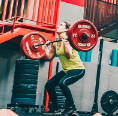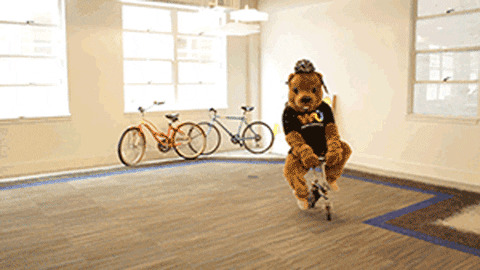CrossFit Olympic Lifts | Training Tips for Athletes
FREE WEIGHTLIFTING WORKOUT!
Download by entering below

How To Olympic Lift For Crossfit
Let’s start our discussion by speaking about the Olympic lift movements CrossFit uses. CrossFit will use a wide range of Olympic lifting movements. CrossFit uses the snatch and many variations, including various hang positions, powers, fulls, and overhead squats. CrossFit will also use the clean and clear and jerk variations, including power cleans, hang cleans, and squat cleans. CrossFit will also use other variations like a barbell thruster. CrossFit athletes are also asked to perform Olympic lifting movements by cycling the barbell through touch and go movement. We have to know the technique around the snatch, clean, and jerk.
Keeping the technique simple, the basic technique requires the athletes to keep the bar tight to the body right off the floor to the knee, meaning the knees need to come back. As the bar passes the knees, the knees need to reciprocate as the bar remains as tight to the body as possible. The bar then comes into the hip and has a powerful finish that is best executed by keeping the feet flat as long as possible before getting plantar flexing and entering the receiving position. Think about performing an explosive jump that is flat-footed to keep the feet grounded as long as possible.
With this basic understanding, we can go into how to be a better CrossFit athlete.

The Snatch
It all starts with the grip. We want the bar in the hip with the thumbs hooked. Grip established we can go to the floor. The idea is to keep the bar over the shoelaces, not the toes. We then apply force through the back, middle, and front of the foot. The knees are then pushed back. When the bar is just below the knees, the shin should be vertical. The bar then passes the knees and the knees start to come forward–an eagle-eyed watcher will notice the bar is still over the shoelaces in this position. We then bring the bar into the hip while remaining flat-footed. At this point, we have the most explosive generation of power. Off the hip, we want to see the elbows come back, rotate the bar, and initiate the catch.

The Clean
Again, keep the bar as tight as possible to the center of mass. Like the snatch, keep the bar over the shoelaces. Another thing to keep in mind is to not have too much weight in the heels. Doing so will cause the toes to pop. We don’t want that to happen. The clean pull is then the execution of the same principles as the snatch. Pulling off the floor the knees come back, knees come under, into the hip, shrug, and finish. Try to not allow the bar to get more than a fist's width away from the body.
Push Press, Split Jerk, Thruster
With the push press, start with a slight dip and a strong drive. We want a good tight dip with no rocking. The chest needs to stay stable and upright. The drive out of the dip needs to continue with constant vertical force. Athletes with a huge front squat can dip a little bit deeper if that is what they are used to. Athletes lacking concentric strength, like someone who cleans 90% of their best front squat, probably should have a shorter dip because they are more explosive than they are strong.
With a split jerk, we want to see a 4-6” dip. Some athletes may dip 6-8”. It depends on height. From the dip, we want to see the long drive similar to the push press. After the dip and drive, we want 50% of the weight going forward and 50% going back as the athlete goes into the split. Recover the front foot first. Pay attention to the width of the feet in the split. The feet need to get to the same width they were at when the athlete received the clean.
The thruster needs us to go back to the push press mindset. The thruster starts with a front squat. After the front squat, we want to keep accelerating out of the squat into the push press. A big thing with the thruster is having the eccentric strength to reload the bar back to the front rack position, squeezing through the gut, quads, and glutes. Having a strong push press helps.

Barbell Cycling
A big difference between weightlifting and CrossFit is cycling a barbell. Weightlifting does not require the cycling of a barbell. CrossFit does require barbell cycling. CrossFit asks athletes to do 10+ reps in a workout of various weightlifting movements. In CrossFit, it is advantageous to execute barbell cycling.
I believe CrossFit athletes lose time by losing positioning during the eccentric part of the cycling. Keep the bar over the shoelaces! Keeping the bar over the shoelaces will keep the bar tight on the eccentric part to eliminate getting pulled on the toes and then compounding the problem more by jumping back on the concentric.
Think about keeping the knees back, finishing flat-footed, catching, and using the traps, rhomboids, and holding the hook grip as the bar is lowered. We also want to load the hamstrings and quads when lowering the bar while keeping the bar over the shoelaces. Touch the bumpers down and go similar to a deadlift. Use that stretch-shortening cycle to make the lift launch off the ground.
Athletes who struggle with touch and go barbell cycling can build the capacity more naturally by starting with hang movements. The shorter the eccentric the easier the cycling of the barbell tends to be if we don’t factor in grip. As the touch and go cycling capacity builds from the hang, the athlete will transition better to the touch and go movements that need an eccentric to the ground.
When making contact with the ground, the big key is to maintain the push through the heels. Here is where the heels cue comes into play very, very well.

Speed Ladder, Max Ladder, Max Out Session
Think of a ladder as asking an athlete to perform an Olympic weightlifting movement at 70%, 75%, 80%, 85%, or higher as fast as possible. Ladders can be done as fast as thirty seconds. One way to train the ladder is to do the lift, put the weight on as fast as possible, and do the lift. This can be done in a training situation for four or five sets. For each set, the weight can be a little bit heavier as well.
For a max ladder, especially if being confined by an area that doesn’t allow an actual ladder to occur, we think an EMOM routine of building weight simulates a max ladder pretty well. Now with the snatch, weightlifters tend to get in a groove and will at times hit PR lifts.
With max-out sessions, weightlifters tend to have around 40 minutes to work towards a max. In CrossFit, that usually isn’t the case. It is more like a 10 to 12-minute window, sometimes even shorter. With that in mind, the CrossFit athlete can do max-out sessions week to week like this to see the progression being made.
Recap
Understand the whole goal is to become a better CrossFit athlete. We also want to establish that the technique shit needs to be established first. The technique shit is established, we can move on to the muscular shit. We can see discrepancies in the movement, where they suffer, and fix them to enhance the technique shit. And finally, we want to put the two together to perform better as a CrossFitter when being challenged with various weightlifting tests.
Related Posts
Blog Topics

Yo, It's Dane
Welcome to the Garage Strength Blog, where it is my goal to provide you with the experience and knowledge I've gained in the strength and conditioning world over many years of learning from both successes and failures. I train elite-level athletes in a multitude of sports from the high school to professional levels, already producing 5 Olympics and 30+ National Champions. If you want to be the next champion I train, check out my strength programs below!
Start Training With Me

Join for free educational videos EVERY WEEK on strength coaching and athletic performance



